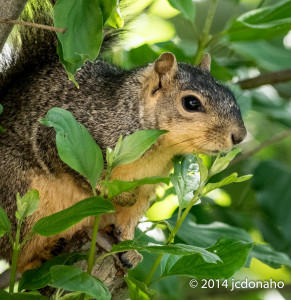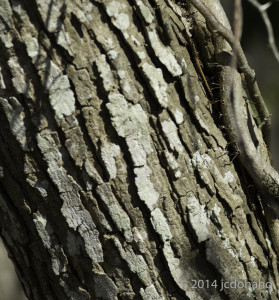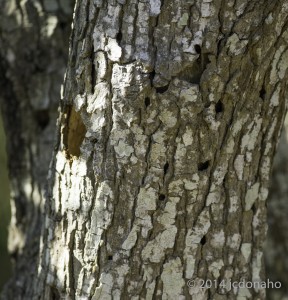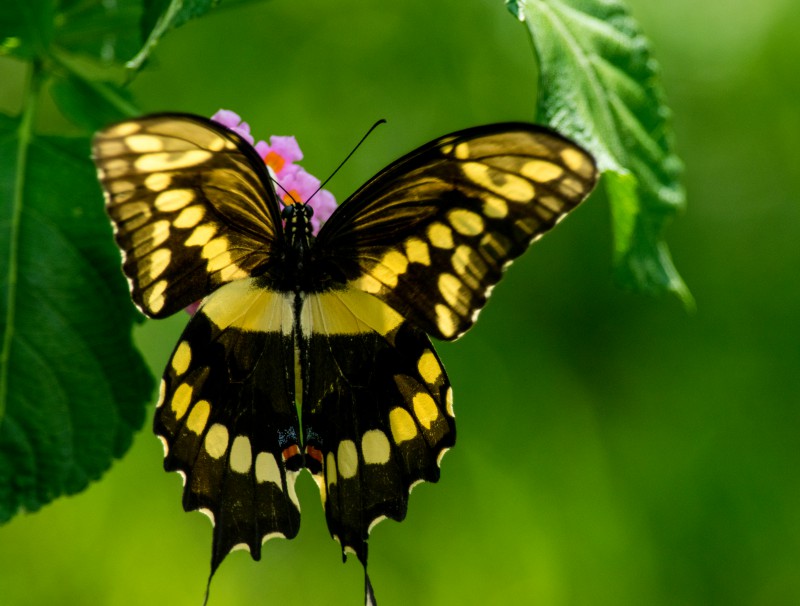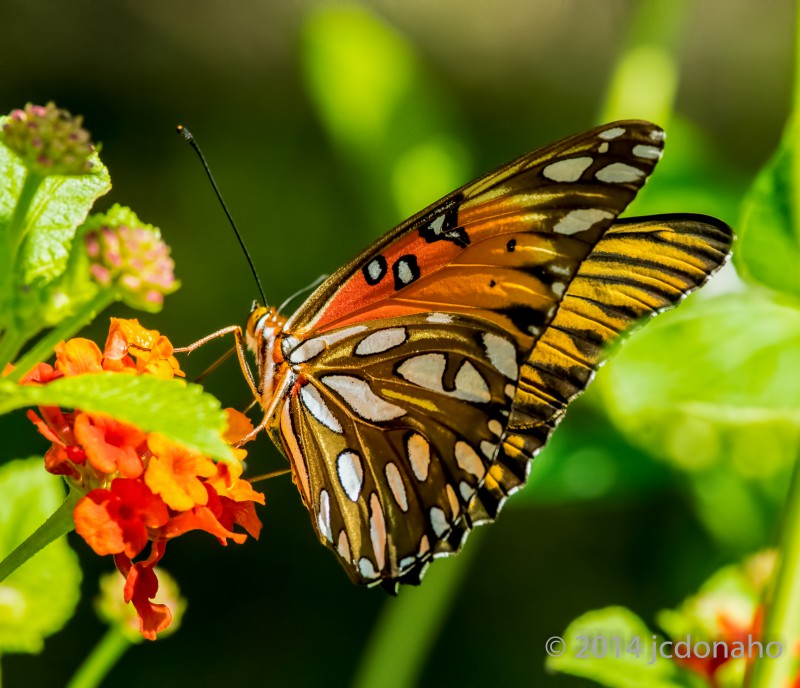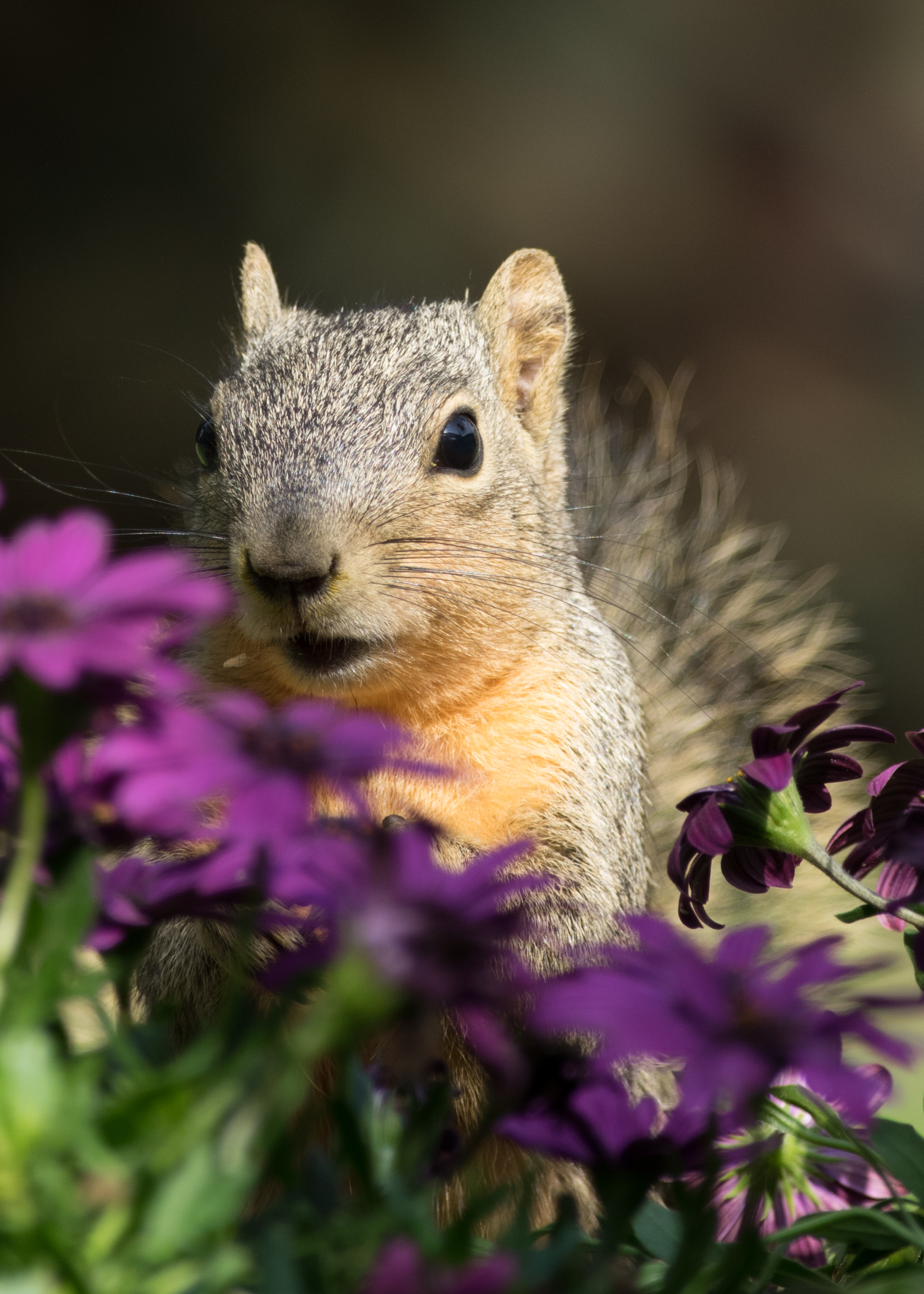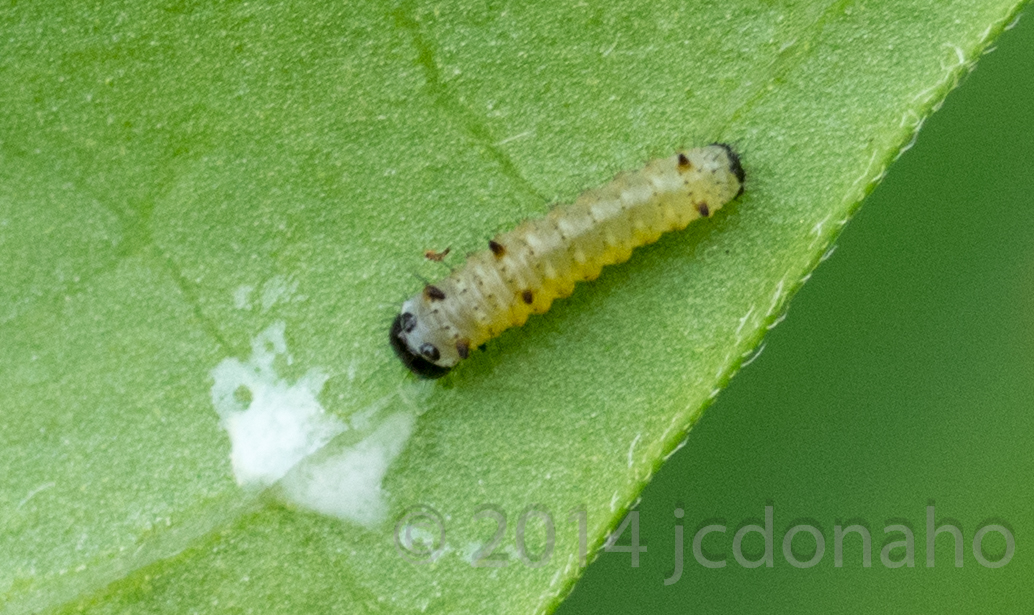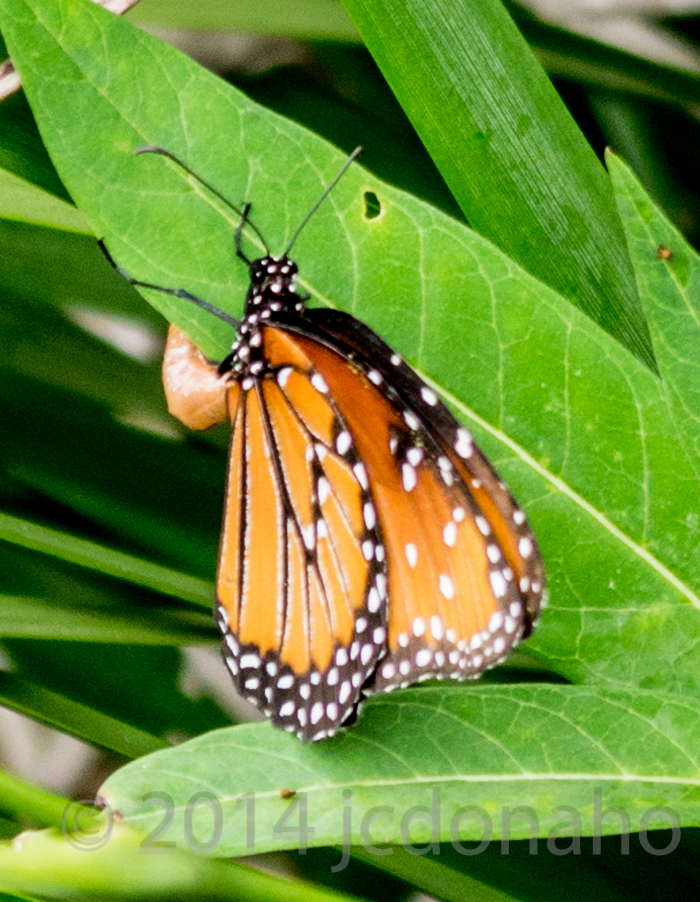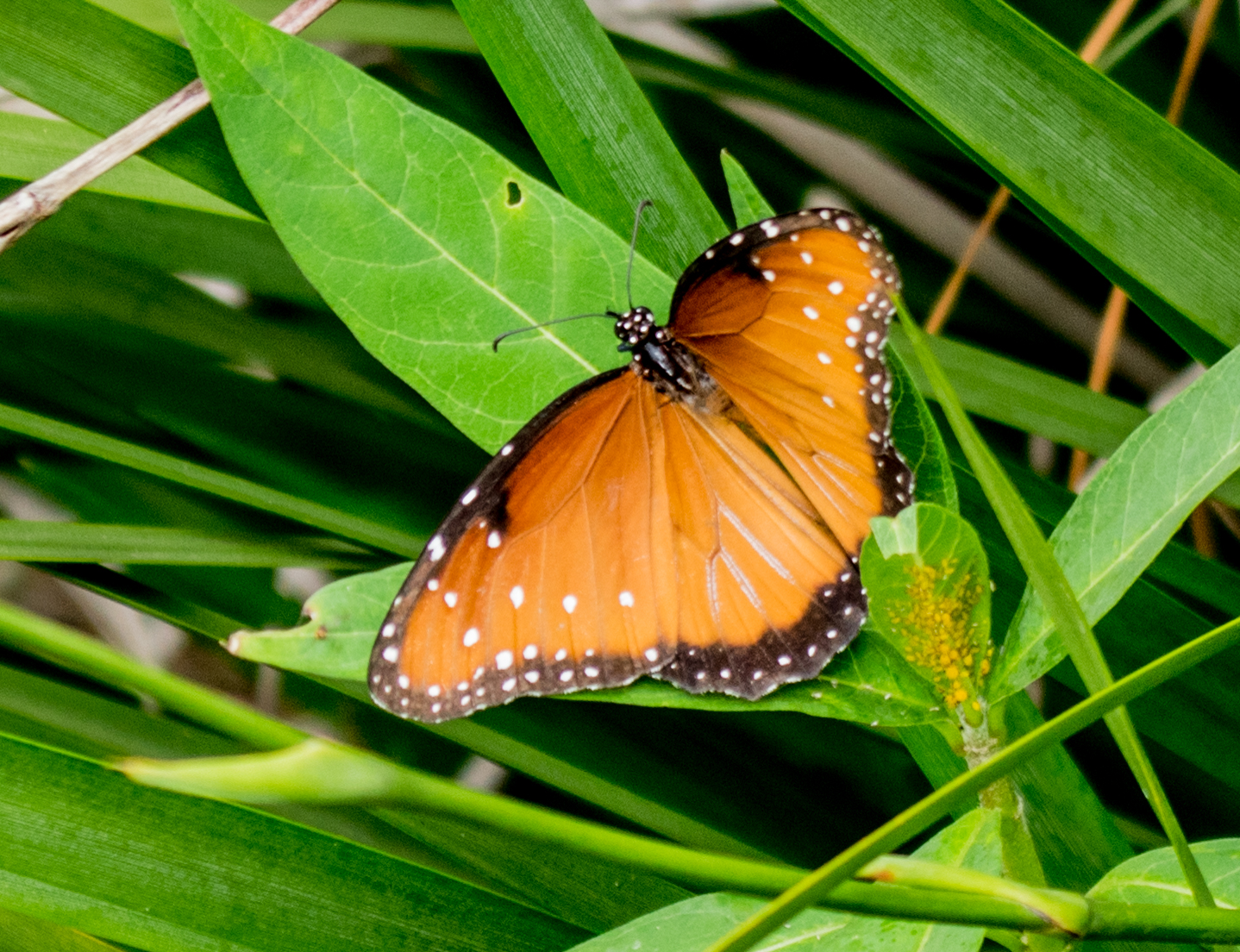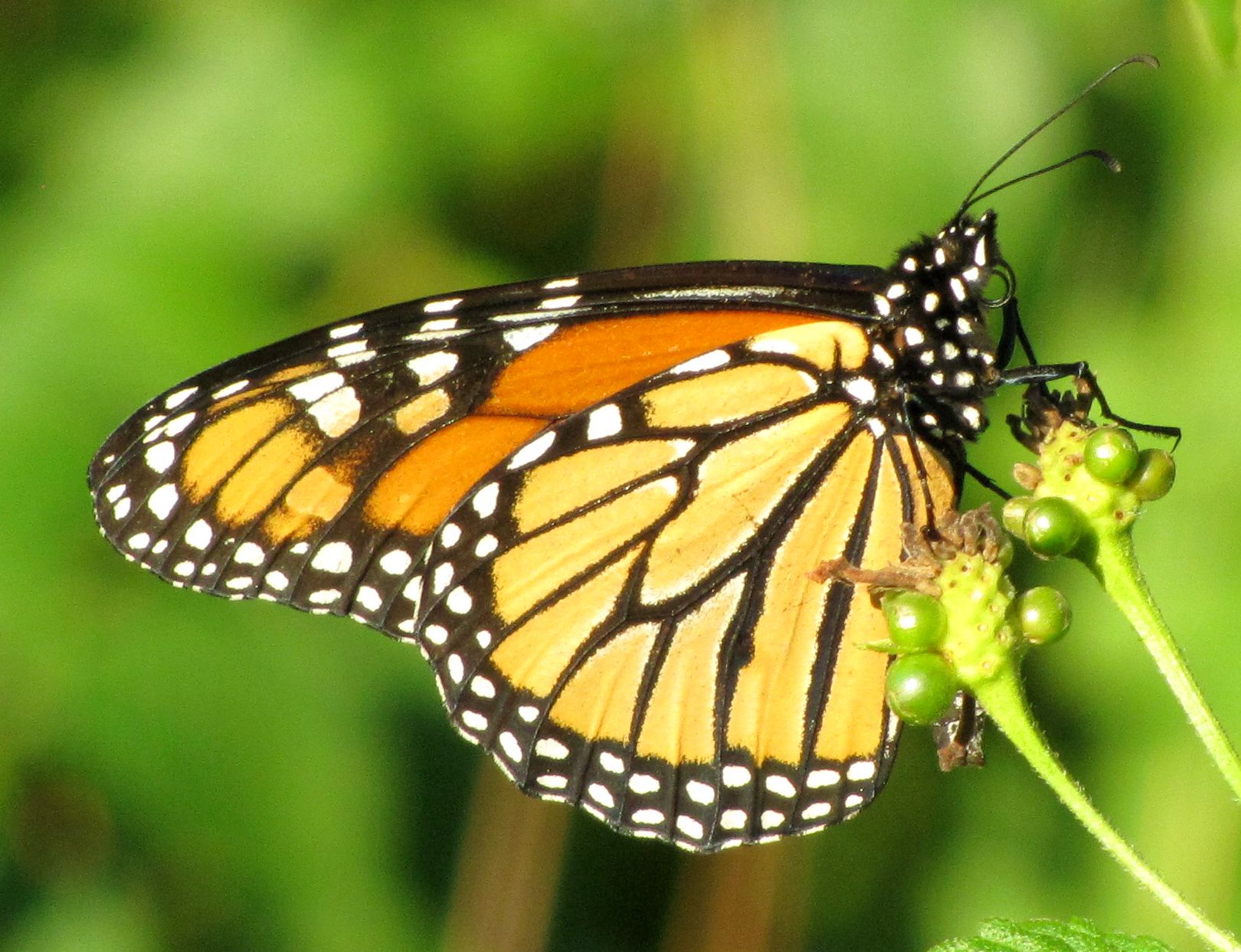Readers’ Favorite is proud to announce that “There’s a Bug in my Blossom” by J.C. Donaho is a Silver Medal Winner in the Children – Non-Fiction category in our 2015 International Book Award Contest. J. C. Donaho is pictured receiving the Silver Medal from Mark Wayne Adams at the awards ceremony held in Miami in November.
Archives
Where Do Bugs Go in Winter?
Freddy Squirrel is asking where did the bugs go? The weather is cold outside. Maybe the bugs have gone inside? Some do exactly that! Ladybugs often go inside warm houses during winter. It is how they cope with cold temperatures.
Then why can’t bugs stay outside in the cold?
An insect’s body temperature is pretty much going to be the same temperature as outside. They are not capable of regulating their body temperature like we can. The fluids in their bodies, their “blood”, can freeze. So, insects have developed strategies to deal with the cold and survive to reproduce and carry on the species.
How do they do that?
There are five ways for insects to survive the winter. Some, like ladybugs, simply move into our warm buildings. Some insects leave or migrate to warmer climates. Some insects survive cold weather by massing in large groups multiplying the tiny amounts of heat each bug generates thus warming the entire group. Other insects go into a state of suspension called diapause or they produce an antifreeze that allows them to withstand freezing temperatures without cell damage.
That’s pretty cool! Or cold! What insects migrate away from cold?
One of the most famous is the Monarch Butterfly. The Monarch can migrate over 3,000 miles from Canada to Mexico!
Where else do insects go?
Many insects seek warmer places to hide from the cold. Tree bark, cracks and holes in trees or squeezing under boards, rocks or other hiding places provide many places to wait out cold weather. Some go under the soil and many live underwater waiting for springtime.
What about insects that huddle together for warmth?
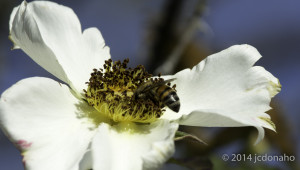
This Honey Bee was out feeding just as soon as the temperature rose above freezing. It was able to stay warm by huddling with other bees in the hive.
You will find ants, termites and bees as examples of insects that group together in hives or underground to maintain warmth. Bees can raise body temperatures by moving their wing muscles. Ants mass underground or above ground in mounds to wait out the cold weather.
The Fire Ants found here on the Texas Gulf coast have another unique way to stay warm. They build their mounds high in cold months to serve as solar collectors of the sun’s rays. The sun warms the mound during the day and helps the ants survive the winter. Some of us wish they did not survive. Imported Red Fire Ants are an invasive species brought into the United States by mistake in the 1930’s. They are now found from Florida to Texas and Oklahoma. They are very destructive because they have no natural predators or diseases in the U.S. to keep them under control. They have also displaced native species like the Red Harvester Ant that is an important food of the Horned Lizard. Without the Red Harvester Ants, populations of Horned Lizards have plummeted in Texas.
What is diapause then?
Diapause is the ability of an animal to go into a state of suspension for long periods. It doesn’t need to eat or drink during this time. Insects go into diapause, then when the weather warms up they resume whatever life stage they are at currently. Some insects go through winter in the egg, some as a chrysalis and some as adults hiding away in warm protected spots until spring.
Insects can use crevices and cracks in tree bark, spaces under rocks or just about any place that shelters them from the cold. Woodpeckers know that bugs like to hide under the bark in trees. Look at all those holes!
The woodpecker found some insects here!
Yes, some insects produce glycerol which prevents the liquid in their cells from freezing. It is a chemical very similar to what we put in our car’s radiator to keep water flowing even in very cold freezing weather. Some insects can even freeze solid overnight, then thaw out the next day as temperatures warm and go about their work as an insect.
So, the answer is that insects go a lot of places, and a lot of them are very close to where you would normally expect to find them.
The Latest Review is In!
The Picture Book Review likes my book! “..this book dazzles, entertains, and educates…” Check it out at thepicturebookreview.com!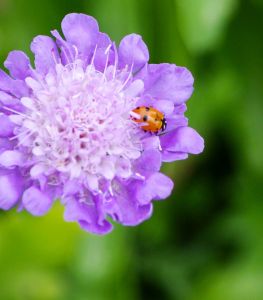
The Amazing Flight of the Butterfly
Have you ever tried to watch a butterfly fly? It is very difficult to do. Even the swallowtail, one of the slowest fliers, still flaps its wings in a figure eight pattern five times a second. That’s 300 times a minute! Only by using photography and slow motion video are we able to watch what is really happening.
Flight is achieved via muscles connecting the wings to the thorax. The muscles are tiny yet they can propel some Monarch butterflies on a migration of over 3,000 miles! That is pretty amazing to me.
Look at the King Swallowtail Butterfly in the background of this photo. You can see that there are really two sets of wings, upper and lower, each capable of moving independently. That wing design gives the butterfly the ability to hover or change direction very quickly. The King Swallowtail in the foreground is at rest appearing only to have a single pair of wings. Researchers have found that butterflies in flight make hundreds of tiny wing adjustments each minute. They do this to compensate for wind currents and the turbulence their own wings create. They are complicated flying machines.
This ultra-slow motion video of butterfly flight reveals the figure eight pattern we can’t see in regular speed.
[youtube=http://youtu.be/6GiYfr0qIR4]
Our butterfly season is nearly over here in Texas. The Monarchs are still moving through on their migration, and we have a few Gulf Fritillaries and Swallowtails coming through.
Hummingbirds are on the move!
Good News – Monarch Numbers are up for 2014!
The Monarchs are on the Move – Encouraging population news
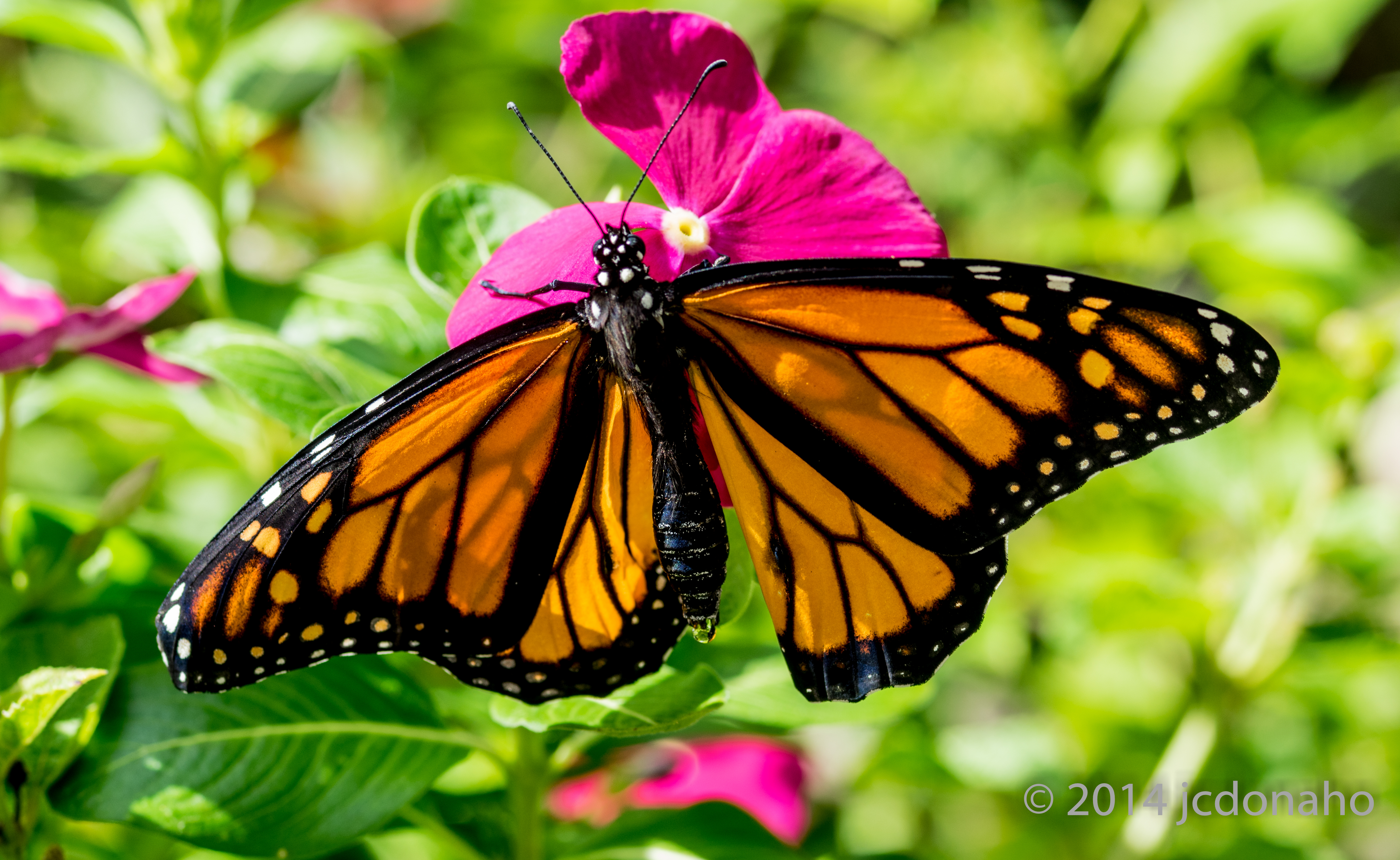
This newly metamorphosed Monarch butterfly is in the process of drying and expanding the wings to take the first flight.
The Monarch Butterfly migration is underway! Monarchs are taking on nectar to build energy stores for the migratory flight to their winter home in Mexico. From Minnesota, Iowa and other points north, reports are that the migration has started. The good news this year is that the Monarch population appears to be on the upswing. That is very good news indeed. There was concern that recent population drops would become an annual trend.
You can help during the migration by making sure you have flowering plants available such as:
Buckwheat (Eriogonum)
Butterfly Bush (Buddleia)
California Lilac (Ceanothus)
Citrus (Citrus)
Coneflower (Echinacea)
Coreopsis (Coreopsis)
Cosmos (Cosmos)
Daisy (Aster and Chrysanthemum)
Dianthus (Dianthus)
Heliotrope (Heliotropium)
Lantana (Lantana)
Marigold (Tagetes)
Milkweed (Asclepias)
Pincushion Flower (Scabiosa)
Rabbit Brush (Chryssothamnus)
Rock Cress (Arabis)
Salvia (Salvia)
Senecio (Senecio)
Star Clusters (Pentas)
Sweet Alyssum (Lobularia)
Verbena (Verbena)
Wall Flower (Erysimum)
Zinnia (Zinnia) -list from the Monarch Program
Many of these plants are very easy to grow.
Use this link to track the progress of the migration.
Use this link for more information on the Monarch including gardening for Monarchs.
Clearly this is not a bug!
 There is a lot more to see in a garden or field than just plants. Flowers are nature’s way of attracting a wide variety of creatures. Many plants need wildlife to help with pollination. A flower or vegetable garden or a field of blooming weeds is full of life. Some come directly to feed on nectar or collect pollen such as bees, butterflies and hummingbirds. Others, like spiders, wasps, assassin bugs and praying mantis, are attracted to areas with flowers because the bugs they eat are in the plants. Then, larger animals such as lizards and birds are attracted to the area because of the variety of insects they can find there.
There is a lot more to see in a garden or field than just plants. Flowers are nature’s way of attracting a wide variety of creatures. Many plants need wildlife to help with pollination. A flower or vegetable garden or a field of blooming weeds is full of life. Some come directly to feed on nectar or collect pollen such as bees, butterflies and hummingbirds. Others, like spiders, wasps, assassin bugs and praying mantis, are attracted to areas with flowers because the bugs they eat are in the plants. Then, larger animals such as lizards and birds are attracted to the area because of the variety of insects they can find there.
Hummingbirds are a special sight. They are fun to watch at a hummingbird feeder, but watching them feed at flowers is more fun to me. This little female Ruby-throat Hummingbird checked out every bloom in the garden. I was able to catch a picture of her feeding at the aptly named Hummingbird flower yesterday. She seems to prefer Hibiscus flowers too.
Some butterflies like specific flowers. The Monarch butterfly requires the Butterfly Weed, also known as Milkweed, to lay eggs.
The Monarch larvae or caterpillars feed almost exclusively on Milkweed as they grow and prepare to undergo metamorphosis into a butterfly. Other butterfly species have their preferred plants too. When you think about it, that helps reduce the new caterpillars’ competition for the same plants after the butterfly eggs hatch. Caterpillars have to eat a lot to grow and turn into a butterfly!
I have a wide variety of flowers in my back yard to hopefully attract different types of wildlife. It works beautifully most of the time. I have discovered that something must be missing though. A beautiful Tiger Swallowtail Butterfly passes through the yard several times a day without stopping. They like daisies. I have a daisy plant in a pot. Perhaps they require more than one pot of daisies to make it worthwhile to stop and feed?
A great place to watch for butterflies, insects and other animals attracted by flowers is at a garden center. The large concentration of flowering plants attracts a lot of attention from insects. And it is free to walk around! Some of the pictures for There’s a Bug in my Blossom were taken at garden centers.
We can enjoy all that nature has to offer whether in our own yard, at the park or a garden center. We just need to get out and observe. And yes, sometimes flowers attract all sorts of wildlife!
UPDATE: What Is That Butterfly Doing?
The next stage of butterfly growth has begun. This is day 4 since I saw the female Queen Butterfly lay an egg on this leaf. What we are seeing is the 1st instar stage of the new caterpillar. As you can see, it is very tiny. It is very hard to see without a magnifying glass. But it will grow rapidly and then molt (shed the old skin) into the next larger instar. The Queen Butterfly caterpillar will go through 5 instar stages before it goes into the pupal stage to complete the metamorphosis into a butterfly. I am going to continue trying to follow this caterpillar on its journey from egg to butterfly. Will he or she make it? There are many perils for small animals in the wild. Stay tuned!
What is that Butterfly Doing?
A couple of days ago, I happened to see a lovely orange butterfly in the front flowerbed. But it wasn’t going to the flowers. It was landing deep in the plant. I thought that was weird. Normally the butterflies are flitting from flower to flower drinking nectar. What is that butterfly doing?
The camera was handy so I took a few shots. I wanted to identify the butterfly and maybe get a good picture. I didn’t have my best butterfly lens installed on the camera at that time so the pictures are not as good as I like.
What I did see in those pictures was the butterfly laying eggs.
That is what she was doing down inside the leaves of the plant! By the time I came back out with a good macro lens, she was gone. Carefully lifting leaves, I found several small single white eggs on the plant’s leaves. She had placed them one to a leaf.
It was time for some research on this butterfly. I am hardly an expert on insects. Each time I see something new I have to research it to understand what I have seen. That is part of the fun of doing wildlife photography. It is fun doing the research and learning about this wonderful world.
It was a Queen Butterfly that I had seen in my garden that day. I, at first, thought she might be a Monarch. But the Queen doesn’t have those dark black wing veins like a Monarch. Monarch wings remind me of a stained glass window.
I found out that the Queen Butterfly is found in many parts of the world with temperate climates. The milkweed plant she used to lay her eggs was chosen as a host because the Queen butterfly caterpillars or larvae feed on milkweed. This is a common tactic with many insects to assure the young have the correct food source. If you know the food source of the caterpillar or other insect young, you can usually find those insects. I also found out in my research that the Queen does indeed lay only one egg per leaf. This makes sense since the newly hatched caterpillars will have less competition for food on their leaf when they hatch. They also tend to eat other small caterpillars!
If all goes well, the caterpillar will emerge from the egg in another day or so. It takes 3-5 days for the egg to ‘hatch’. I hope to see and photograph the new caterpillar at that time. The caterpillars go through growth stages called instars. It will be fun to watch them eat, poop and grow over the summer.
A side benefit of looking so closely under the leaves was discovering the tiny Yellow Aphids. If they become too numerous they can cause the plant to die. The only safe method I can find to rid the plant of aphids without killing the butterfly eggs too is to dab each aphid with a cotton swab soaked in rubbing alcohol. I may let nature take its course instead. I’ll find out pretty quickly if the young caterpillars will eat aphids.
Stay tuned. This is the first time I have tried following a butterfly life cycle “in the wild”. It should be fun!

